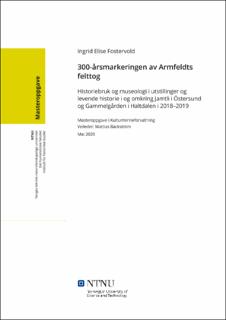| dc.contributor.advisor | Bäckström, Mattias | |
| dc.contributor.author | Fostervold, Ingrid Elise | |
| dc.date.accessioned | 2021-09-13T16:03:15Z | |
| dc.date.available | 2021-09-13T16:03:15Z | |
| dc.date.issued | 2020 | |
| dc.identifier | no.ntnu:inspera:59159411:34690130 | |
| dc.identifier.uri | https://hdl.handle.net/11250/2775533 | |
| dc.description.abstract | I forbindelse med 300-årsmarkeringen av Armfeldts felttog i 2018 og 2019, ble det gjennomført ulike markeringer. Aktørene bak disse markeringene var ofte sammensatte grupper av forskjellige personer i samfunnet. Masteroppgaven tar for seg to utstillinger og to arrangementer i og omkring Jamtli i Östersund og Gammelgården i Haltdalen. Ved å se på faktorene aktør, sted og medium, vil kulturproduktene analyseres opp mot teorier innen historiebruk og museologi, for å finne ut hvilken historiebruk som ble anvendt og hvilken museologisk tradisjon aktørene og kulturproduktene tilhører. Kulturproduktene analyseres også opp mot begrepsparet resonans og forundring, og begrepsparet narrativ utstilling og tolkende utstilling, for å si noe om hvordan gjenstander anvendes i utstillingene, så vel som arrangementene.
Funnene i denne oppgaven tilsier at Gammelgården og aktørene bak marsjen «I Armfeldts fotspor» defineres innenfor økomuseumsmodellen, og at utstillingen anvender en narrativ utstillingsform hvor gjenstandene resonerer tematikken i utstillingen. Historiebruken er identitetsskapende. Jamtli som aktør kan plasseres innenfor den anglosaksiske formen for ny museologi, og utstillingen og arrangementet «karolinervinter» bærer et narrativt uttrykk. Også her skapes det resonans til krigen gjennom å bruke friluftsmuseet og gjenstander. | |
| dc.description.abstract | In 2018 and 2019, several various commemorations were held in conjunction with the 300-year anniversary of the Swedish invasion of Norway during The Great Northern War. The actors behind the commemorations were often composed of different people of various backgrounds. This master’s thesis looks at two exhibitions and two events held in and around Jamtli in Östersund, and Gammelgården in Haltdalen. These cultural products are analyzed by looking at the factors actor, place and medium, against theories within the use of history and museology, to find which use of history was applied and which museological tradition the actors and cultural products belong to. They are also analyzed against the concepts of resonance and wonder, and narrative and interpretive exhibitions, with the intention of finding out how items are used in these exhibitions and events.
The findings of this thesis suggests that Gammelgården and its actors behind the march «In the footprints of Armfeldt» are defined within the eco museum model, and that the exhibition uses a narrative form where the items resonates the exhibitions themes. The use of history creates and identity. As an actor, Jamtli can be categorized within the Anglo-Saxon tradition of new museology, and the exhibition and event «karolinervinter» has a narrative expression. The use of items and an open air musem creates resonance to the war. | |
| dc.language | | |
| dc.publisher | NTNU | |
| dc.title | 300-årsmarkeringen av Armfeldts felttog
Historiebruk og museologi i utstillinger og levende historie i og omkring Jamtli i Östersund og Gammelgården i Haltdalen i 2018–2019 | |
| dc.type | Master thesis | |
